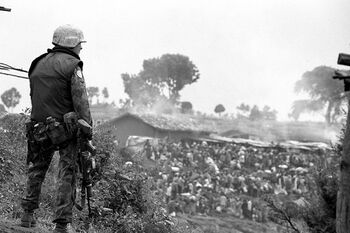Agarput Crisis: Difference between revisions
No edit summary |
No edit summary |
||
| Line 23: | Line 23: | ||
* {{flagicon image|KaliCultFlag.png|border=}} [[Anak-anak Dewi]]<br /> | * {{flagicon image|KaliCultFlag.png|border=}} [[Anak-anak Dewi]]<br /> | ||
---- | ---- | ||
Islamist Rebels<br /> | {{flagicon image|Southagarput.png|border=}} Islamist Rebels<br /> | ||
* {{flagicon image|JemaahIslam.jpg|border=}} [[Jemaah Islamiyah]] | * {{flagicon image|JemaahIslam.jpg|border=}} [[Jemaah Islamiyah]] | ||
| units1 = | | units1 = | ||
| Line 65: | Line 65: | ||
==Background== | ==Background== | ||
The Agarput republic has often been defined by its religious divide. The north of the island is predominantly Hindu, while the south holds a significant Muslim population. Tension between these groups date back centuries, and both religious groups trace their lineage to various invasions which have occured throughout the islands history. In the mid 1950s through to mid 1960s the island suffered under a continual Islamist insurgency which only ended with the partial recognition of the southern areas of Pengceluk and Gerokgak and withdrawal of Agarput troops from these areas. | |||
Violence between Muslim and Hindu Agarputs flared up again in the 1980s following an effort by authoritarian president Gebe Ksatria to reclaim the wayward regions. This conflict ended in disaster for the Agarput government, resulting in a Thalassic Federation-brokered ceasefire in 1981. The Ksatria government promptly collapsed later in that same year, with the country briefly falling into civil war, ending with a pro-Federation government in control of the Agarput government. In 1984 the Agarput Republic held a referendum regarding special membership within the Thalassic Federation wherein they would retain local government and autonomy while joining the Federation and benefitting from Federation assistance. The vote was successful with 62% of the population voting to become a member of the Thalassic Federation. | |||
==Voting and violence== | ==Voting and violence== | ||
The Thalassic vote was strife with intimidation and violence, nationalist groups, most of whom were loyal to the now-imprisoned Ksatria, assaulted voting booths and discouraged citizens from attending the vote. Afterwards, these groups also rose up in protest against the Thalassic takeover of the country. Sporadic violence ensued but was promptly stifled by local police, and discontented elements of the public were sated with generous Thalassic infrastructure and reconstruction spending. | |||
Revision as of 01:22, 7 April 2022
| 1987 Agarput crisis | |||||||
|---|---|---|---|---|---|---|---|
 Thalassic Soldier outside Taman, Agarput Republic | |||||||
| |||||||
| Belligerents | |||||||
|
Supported by:
|
| ||||||
| Commanders and leaders | |||||||
|
| |||||||
| Units involved | |||||||
|
| |||||||
| Strength | |||||||
|
8,000 soldiers 36 Aircraft 1 LHD, 1 Destroyer, 2 Assault ships |
| ||||||
| Casualties and losses | |||||||
|
116 killed 209 wounded |
400+ killed 500+ wounded 3,187 arrested | ||||||
|
1,400+ civilians 220,000+ refugees | |||||||
The 1987 Agarput crisis began after a period of political and economic instability in the Agarput Republic shortly after its incorporation into the Thalassic Federation. Fighting began with attacks by Hindu extremist group Anak-anak Dewi targeting the local government senate offices, killing 102 civilians and administrators, including eight visiting Federation diplomats. Immediately following this the Thalassic Federation Ground Forces deployed the 5th Brigade to assist in reconstruction and peacekeeping efforts. Shortly thereafter local strife erupted into combat between Thalassic forces and local extremist groups, including nationalist brigades Agarput Anyar, as well as Hindu and Islamic extremists. These disparate groups, despite principally being opposed to the Thalassic Forces, would very regularly attack one another.
Background
The Agarput republic has often been defined by its religious divide. The north of the island is predominantly Hindu, while the south holds a significant Muslim population. Tension between these groups date back centuries, and both religious groups trace their lineage to various invasions which have occured throughout the islands history. In the mid 1950s through to mid 1960s the island suffered under a continual Islamist insurgency which only ended with the partial recognition of the southern areas of Pengceluk and Gerokgak and withdrawal of Agarput troops from these areas.
Violence between Muslim and Hindu Agarputs flared up again in the 1980s following an effort by authoritarian president Gebe Ksatria to reclaim the wayward regions. This conflict ended in disaster for the Agarput government, resulting in a Thalassic Federation-brokered ceasefire in 1981. The Ksatria government promptly collapsed later in that same year, with the country briefly falling into civil war, ending with a pro-Federation government in control of the Agarput government. In 1984 the Agarput Republic held a referendum regarding special membership within the Thalassic Federation wherein they would retain local government and autonomy while joining the Federation and benefitting from Federation assistance. The vote was successful with 62% of the population voting to become a member of the Thalassic Federation.
Voting and violence
The Thalassic vote was strife with intimidation and violence, nationalist groups, most of whom were loyal to the now-imprisoned Ksatria, assaulted voting booths and discouraged citizens from attending the vote. Afterwards, these groups also rose up in protest against the Thalassic takeover of the country. Sporadic violence ensued but was promptly stifled by local police, and discontented elements of the public were sated with generous Thalassic infrastructure and reconstruction spending.